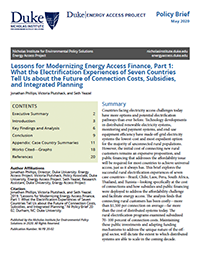Countries facing electricity access challenges today have more options and potential electrification pathways than ever before. Technology developments in distributed renewable electricity systems, monitoring and payment systems, and end-use equipment efficiency have made off-grid electricity systems the lowest-cost and most expedient option for the majority of unconnected rural populations. However, the initial cost of connecting new rural customers remains an expensive proposition, and public financing that addresses the affordability issue will be required for most countries to achieve universal access, just as it always has. This brief explores the successful rural electrification experiences of seven case countries—Brazil, Chile, Laos, Peru, South Africa, Thailand, and Tunisia—looking specifically at the cost of connections and how subsidies and public financing were deployed to address the affordability challenge and facilitate energy access. The analysis finds that connecting rural customers has been costly—more than $1,500 per connection on average—far more than the cost of distributed systems today. The rural electrification programs examined subsidized 70–100 percent of connection costs. Maintaining these public investments and adapting funding mechanisms to address the unique nature of the off-grid sector, will dictate the extent to which distributed systems are able to scale in the coming decade.

